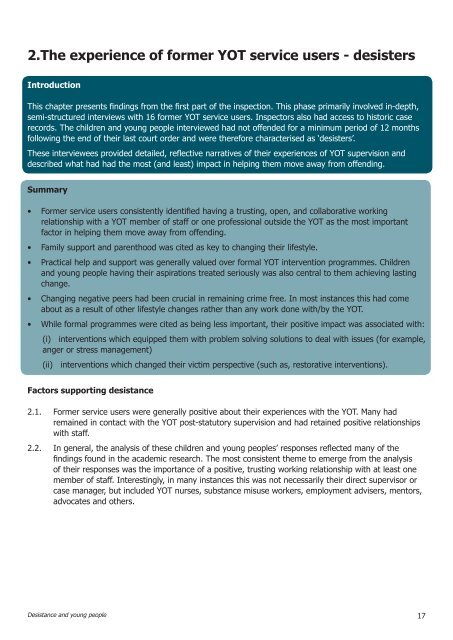Desistance and young people
Desistance_and_young_people
Desistance_and_young_people
You also want an ePaper? Increase the reach of your titles
YUMPU automatically turns print PDFs into web optimized ePapers that Google loves.
2.The experience of former YOT service users - desisters<br />
Introduction<br />
This chapter presents findings from the first part of the inspection. This phase primarily involved in-depth,<br />
semi-structured interviews with 16 former YOT service users. Inspectors also had access to historic case<br />
records. The children <strong>and</strong> <strong>young</strong> <strong>people</strong> interviewed had not offended for a minimum period of 12 months<br />
following the end of their last court order <strong>and</strong> were therefore characterised as ‘desisters’.<br />
These interviewees provided detailed, reflective narratives of their experiences of YOT supervision <strong>and</strong><br />
described what had had the most (<strong>and</strong> least) impact in helping them move away from offending.<br />
Summary<br />
• Former service users consistently identified having a trusting, open, <strong>and</strong> collaborative working<br />
relationship with a YOT member of staff or one professional outside the YOT as the most important<br />
factor in helping them move away from offending.<br />
• Family support <strong>and</strong> parenthood was cited as key to changing their lifestyle.<br />
• Practical help <strong>and</strong> support was generally valued over formal YOT intervention programmes. Children<br />
<strong>and</strong> <strong>young</strong> <strong>people</strong> having their aspirations treated seriously was also central to them achieving lasting<br />
change.<br />
• Changing negative peers had been crucial in remaining crime free. In most instances this had come<br />
about as a result of other lifestyle changes rather than any work done with/by the YOT.<br />
• While formal programmes were cited as being less important, their positive impact was associated with:<br />
(i) interventions which equipped them with problem solving solutions to deal with issues (for example,<br />
anger or stress management)<br />
(ii) interventions which changed their victim perspective (such as, restorative interventions).<br />
Factors supporting desistance<br />
2.1. Former service users were generally positive about their experiences with the YOT. Many had<br />
remained in contact with the YOT post-statutory supervision <strong>and</strong> had retained positive relationships<br />
with staff.<br />
2.2. In general, the analysis of these children <strong>and</strong> <strong>young</strong> <strong>people</strong>s’ responses reflected many of the<br />
findings found in the academic research. The most consistent theme to emerge from the analysis<br />
of their responses was the importance of a positive, trusting working relationship with at least one<br />
member of staff. Interestingly, in many instances this was not necessarily their direct supervisor or<br />
case manager, but included YOT nurses, substance misuse workers, employment advisers, mentors,<br />
advocates <strong>and</strong> others.<br />
<strong>Desistance</strong> <strong>and</strong> <strong>young</strong> <strong>people</strong><br />
17


